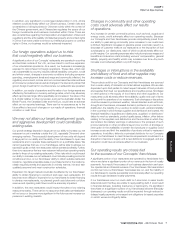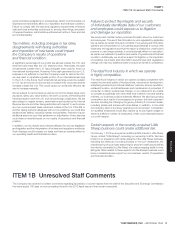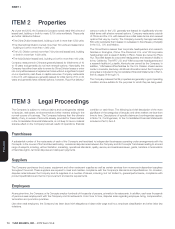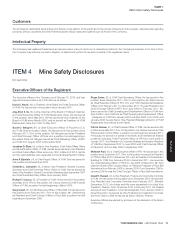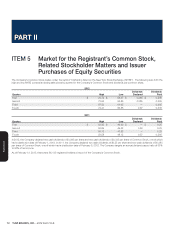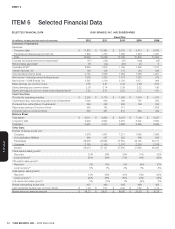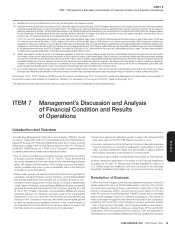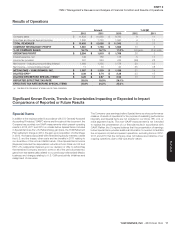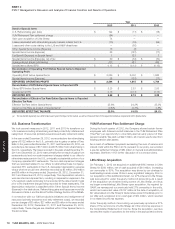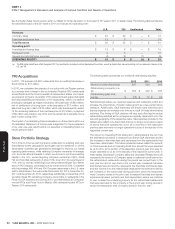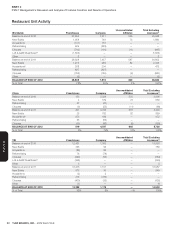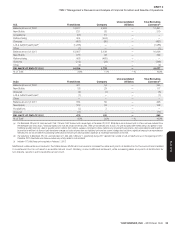Pizza Hut 2012 Annual Report Download - page 107
Download and view the complete annual report
Please find page 107 of the 2012 Pizza Hut annual report below. You can navigate through the pages in the report by either clicking on the pages listed below, or by using the keyword search tool below to find specific information within the annual report.
YUM! BRANDS, INC.-2012 Form10-K 15
Form 10-K
PART II
ITEM7Management’s Discussion and Analysis ofFinancial Condition and Results ofOperations
(a) See Note4 for discussion of Refranchising Gain (Loss) and Store Closure and Impairment Activity.
(b) In addition to the results provided in accordance with U.S. Generally Accepted Accounting Principles (“GAAP”) throughout this document, the Company has provided non-GAAP measurements
which present operating results on a basis before Special Items.The Company uses earnings before Special Items as a key performance measure of results of operations for the purpose of
evaluating performance internally.This non-GAAP measurement is not intended to replace the presentation of our financial results in accordance with GAAP.Rather, the Company believes
that the presentation of earnings before Special Items provides additional information to investors to facilitate the comparison of past and present operations, excluding items that the
Company does not believe are indicative of our ongoing operations due to their size and/or nature.
2012, 2011 and 2010 Special Items are described in further detail within our MD&A. Special Items in 2009 and 2008 include the U.S. refranchising net gain of $34million in 2009 and
U.S. refranchising net loss of $5million in 2008, charges of $16million in 2009 and $49million in 2008 relating to U.S. General and Administrative (“G&A”) productivity initiatives and
realignment of resources, investments in our U.S. Brands of $32million in 2009 and $7million in 2008, a 2009 U.S. Goodwill impairment charge of $26million, the 2009 loss of $10million
recognized as a result of our decision to offer to refranchise an equity market outside the U.S., the 2009 gain of $68million upon our acquisition of additional ownership in, and consolidation
of, the operating entity that owns the KFCs in Shanghai, China, and the 2008 gain of $100million related to the sale of our unconsolidated affiliate in Japan. The items above resulted in
cumulative net tax benefits of $5million in 2009 and net tax expense of $14million in 2008.
(c) System sales growth includes the results of all restaurants regardless of ownership, including Company-owned, franchise, unconsolidated affiliate and license restaurants that operate
our concepts, except for non-company-owned restaurants for which we do not receive a sales-based royalty.Sales of franchise, unconsolidated affiliate and license restaurants generate
franchise and license fees for the Company (typically at a rate of 4% to 6% of sales).Franchise, unconsolidated affiliate and license restaurant sales are not included in Company sales on the
Consolidated Statements of Income; however, the franchise and license fees are included in the Company’s revenues.We believe system sales growth is useful to investors as a significant
indicator of the overall strength of our business as it incorporates all of our revenue drivers, Company and franchise same-store sales as well as net unit development.Same-store sales
growth includes the estimated growth in sales of all restaurants that have been open and in the YUM system one year or more.
(d) Local currency represents the percentage change excluding the impact of foreign currency translation.These amounts are derived by translating current year results at prior year average
exchange rates.We believe the elimination of the foreign currency translation impact provides better year-to-year comparability without the distortion of foreign currency fluctuations.
Fiscal years 2012, 2010, 2009 and 2008 include 52 weeks and fi scal year 2011 includes 53 weeks. See Management’s Discussion and Analysis of
Financial Condition and Results of Operations (“MD&A”) for discussion of the impact of the 53rd week in fi scal year 2011.
The selected fi nancial data should be read in conjunction with the Consolidated Financial Statements.
ITEM7 Management’s Discussion and Analysis
of Financial Condition and Results
of Operations
Introduction and Overview
The following Management’s Discussion and Analysis (“MD&A”), should
be read in conjunction with the Consolidated Financial Statements on
pages36 through 70 (“Financial Statements”) and the Forward-Looking
Statements on page2 and the Risk Factors set forth in Item 1A.Throughout
the MD&A, YUM! Brands, Inc. (“YUM” or the “Company”) makes reference
to certain performance measures as described below.
•
The Company provides the percentage changes excluding the impact
of foreign currency translation (“FX” or “Forex”).These amounts are
derived by translating current year results at prior year average exchange
rates.We believe the elimination of the foreign currency translation
impact provides better year-to-year comparability without the distortion
of foreign currency fl uctuations.
•
System sales growth includes the results of all restaurants regardless of
ownership, including Company-owned, franchise, unconsolidated affi liate
and license restaurants that operate our Concepts, except for non-
company-owned restaurants for which we do not receive a sales-based
royalty.Sales of franchise, unconsolidated affi liate and license restaurants
generate franchise and license fees for the Company (typically at a rate
of 4% to 6% of sales).Franchise, unconsolidated affi liate and license
restaurant sales are not included in Company sales on the Consolidated
Statements of Income; however, the franchise and license fees are
included in the Company’s revenues.We believe system sales growth
is useful to investors as a signifi cant indicator of the overall strength of
our business as it incorporates all of our revenue drivers, Company and
franchise same-store sales as well as net unit development.
•
Same-store sales is the estimated growth in sales of all restaurants that
have been open and in the YUM system one year or more.
•Company restaurant profi t is defi ned as Company sales less expenses
incurred directly by our Company restaurants in generating Company
sales.Company restaurant margin as a percentage of sales is defi ned
as Company restaurant profi t divided by Company sales.
•
Operating margin is defi ned as Operating Profi t divided by Total revenue.
All Note references herein refer to the Notes to the Financial Statements
on pages43 through 70 .Tabular amounts are displayed in millions of
U.S. dollars except per share and unit count amounts, or as otherwise
specifi cally identifi ed. Percentages may not recompute due to rounding.
Description of Business
YUM is the world’s largest quick-service restaurant company in terms of
system restaurants with over 39,000 restaurants in more than 125 countries
and territories operating primarily under the KFC, Pizza Hut or Taco Bell
brands.In December of 2011 we sold our Long John Silver’s (“LJS”) and
A&W All American Food Restaurants (“A&W”) brands to key franchise
leaders and strategic investors in separate transactions. The results for
these businesses through the sale dates are included in the Company’s
results for 2011 and 2010. The Company’s primary restaurant brands
– KFC, Pizza Hut and Taco Bell – are the global leaders in the chicken,
pizza and Mexican-style food categories, respectively.Of the over 39,000
restaurants, 19% are operated by the Company, 75% are operated by
franchisees and unconsolidated affi liates and 6% are operated by licensees.




